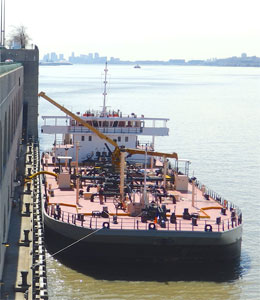The Marine Section of New York City’s Department of Environmental Protection (NYC DEP) has added three significant vessels to its fleet in the past year. These tankers, an essential component of the wastewater treatment process, do not leave city waters on their voyages among the city’s wastewater treatment plants. No treated waste has been dumped at sea for over 20 years, urban legend notwithstanding. On a typical voyage, Hunts Point, the first of three identical new sludge ships to enter service, departs Wards Island dock in ballast at 0700 hours for Manhattan’s North River facility, where it loads partly dewatered waste. By noon the fully loaded tanker casts off lines for the return to the Wards Island plant, where the sludge dewatering can be completed.
Hunts Point was built for NYC DEP by Bollinger Metal Fabricators of Amelia, La. It loaded its first cargo in February 2014. Port Richmond and Rockaway followed in July and September, respectively. The new vessels, costing around $35 million each, have a 290-by-70-foot length and beam. When light, they draw as little as 4 feet, 3 inches forward, and 9 feet, 3 inches aft. The deep draft is 14 feet, 6 inches fully loaded with the foamy, thick cargo.
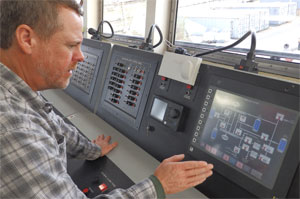 |
|
Capt. Gordon Arnold activates the odor- control system from the bridge. |
NYC DEP Port Captain Gregory Hanchrow uses the word “product” when he refers to the cargo. “People are curious about our operations, but become more interested when they find out what we carry.” Crew define a good day as “when you smell the product but not see it.”
The cargo is produced by the 8 million residents of New York City and 14 sewage treatment plants, only eight of which can fully “dewater” sewage — the term for the end of the process of transforming human waste into clean water and bio-solids for beneficial use, such as rich soil for covering landfills. Alternate solutions for dewatering the rest are upgrading the other six plants or connecting them all with pipelines. But space and cost make those solutions unworkable. Expanding the acreage of existing facilities is not an option in densely populated New York City. Even if it were, the cost would overwhelm NYC DEP’s annual operating and capital budgets. The city’s solution has been sludge ships that Hanchrow describes as “a more cost-effective and flexible pipeline better capable of dealing with variability of flow.”
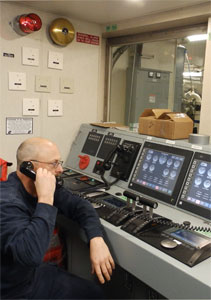 |
|
Hunts Point’s chief engineer, Scott Belfield, communicates with the bridge by phone from the engine room. |
A quick comparison of the profile of the new vessels with the older ones — Red Hook and North River — reveals some parameters that drove the design for the three newbuilds. Since these vessels now accomplish their mission entirely within the harbor, there’s no upswept oceangoing bow, as previous classes had. The first-generation ships, referred to as the Island class and commissioned during the administration of Fiorello La Guardia in the 1930s, took sewage treated with bacteria and chemicals and went offshore 12 miles to dump the cargo. Later, the U.S. Environmental Protection Agency (EPA) required vessels to travel more than 100 miles offshore to dump, a practice that continued until the Ocean Dumping Ban Act of 1988, which prohibited all ocean disposal after December 1991.
Other parameters driving the design relate to the waters navigated and the economy of operation: The newbuilds had to have an air draft of less than 45 feet to enable passage under a bridge over Newtown Creek, a maximum 14-foot deep draft, and 140,000-cubic-foot maximum sludge capacity. This means the new vessels are shorter and shallower and yet have greater cargo capacity than any previous vessels, including the 350-by-53-foot length and beam, 21-foot draft Red Hook, which entered service in 2008.
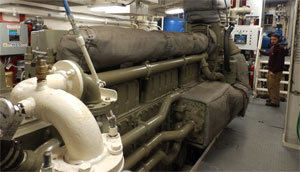 |
|
Pablo Romero, an assistant engineer, is on watch with the GE 6L250 diesel. |
Propulsion power comes from two IMO Tier-II turbocharged GE 6L250 marine diesel engines rated at a combined 3,652 hp. Capt. Gordon Arnold gives high marks to the state-of-the-art integrated ECDIS Kongsberg bridge system. “It’s top-notch,” Arnold said. The AutoChief C20 propulsion control is also from Kongsberg, with stations located on the bridge, on each bridge wing and in the engine room. The variable-pitch propellers have a diameter of 6.89 feet, each turning at a maximum of 300 rpm. Independent of the rudder steering system are fore and aft SST 502 steerable pump jet Schottel thrusters. The bow thruster is rated at 503 hp and the stern 428. “These boats can turn 180 degrees in their own length,” Arnold said. “They are incredibly maneuverable, even in wind conditions.”
The design process started in 2008 when Marine Section chief Kevin Burns, senior port engineer Jim Aird and Hanchrow began discussions on new vessel parameters. When construction started, Arnold and chief engineer Scott Belfield spent many weeks at the Bollinger shipyard overseeing the work, observing the systems as they were assembled and installed, and suggesting adaptations when needed for New York conditions. For example, to ensure that the vessel came equipped to deal with the possible temperature extremes of a New York winter, they suggested increasing the temperature insulation of some superstructure tubes and piping. In addition, because the “product” is mostly water, electric heat tracing and insulation has been installed on most cargo valves to mitigate damage from freezing.
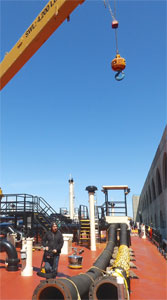 |
|
Hunts Point mate Vinnie Feminella uses the crane’s portable remote-control box to lower the hook toward a product hose. |
Notable on the ships are the remote-control cranes. “You can operate the cranes from anywhere on the boat,” Arnold said. “Particularly during hookups — when the boat hoses get connected to the sewage treatment facility valves — you can take the remote-control box right up close to see what you need to do, giving unparalleled flexibility and safety.”
The three vessels use self-cleaning, submerged Flygt 3301 NP pumps with the capability to move 1,780 gallons per minute at 150-foot total dynamic head. This type of pump resists clogging and is widely used throughout the entire wastewater treatment system in pumping stations in the city and elsewhere.
Integrated with the other cargo-handling components, the new vessels have odor-control systems. “There are three control units built in. They’re quiet, and they do the job,” said Arnold. Besides being a creature comfort for the operators, added Hanchrow, the odor-control systems “play an important role in community relations. Since DEP is a public service utility, priority needs to be given to avoiding problems, specifically really bad odors emanating from a plant during loading and unloading.” The new vessels were designed taking into account the maximum possible throughput of cargo.
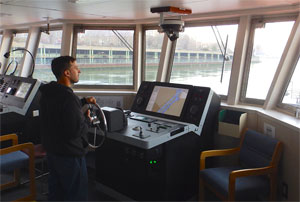 |
|
Feminella is back at the helm, navigating the sewage tanker toward Hell Gate, eastbound and loaded en route to the Wards Island wastewater plant. |
The Marine Section of NYC DEP realized it needed an effective training plan in place once Hunts Point arrived in New York City. “We couldn’t repeat the lag in familiarization and reactive training experienced when Red Hook arrived in 2008,” said Hanchrow, “and we were going to have three new boats arriving.” Red Hook had been the first newbuild for NYC DEP since 1974 and represented a whole new world in integrated systems, but it was one new vessel in a fleet of four. The newbuilds delivered in 2014 represent more than half the fleet of five.
Arnold and Belfield were asked to prepare training for the other captains and engineers on new vessel operation. They began developing a familiarization and training curriculum for every member of the NYC DEP Marine Section. In this, Arnold and Belfield were assisted by CHAND, Bollinger’s subsidiary for full technical support and logistics. Together they developed a 120-hour course so that when new crew came on board for the first time, they already knew “how everything looked and generally worked from the cranes on the deck to the toaster in the galley,” Hanchrow said. Arnold and Belfield, along with mate Vinnie Feminella and assistant engineer Pablo Romero, became the training as well as operating crew. They were, as Hanchrow says, “the brain trust to bring in the other crews from the older boats to ride along and see how the new vessels steer, pump, start up, stop and so on. Training was comprehensive, organized and detailed. They did an awesome job.” As a measure of how well this training worked, Hanchrow said, “Hunts Point went into service two months after arrival, Port Richmond entered in one month and Rockaway was in service in two weeks.”
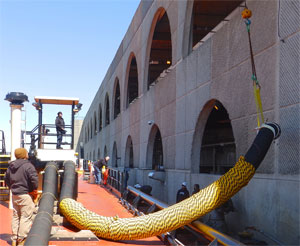 |
|
Feminella and able seaman Jonathan Miller, left, place the product hose into position to connect with the facility’s outflow. |
By November 2014, 90 percent of the crews had successfully finished training on the new vessels. Training may have been completed had the arrival of Rockaway not coincided with United Nations General Assembly sessions on the East River. NYC DEP has the distinction of being the only cargo carrier allowed to pass the U.N. during these sessions. Although DEP vessels can pass, a time-consuming process of coordinating with port security is required. “It’s not free passage,” said Hanchrow. “Trained dogs have to sniff the boats and we embark tactical security teams. The U.N., U.S. Secret Service and U.S. Coast Guard all work together with the DEP to help keep the operation and its schedule going. They recognize we operate a critical service.”
Given the nature of the cargo, the demand never stops.

